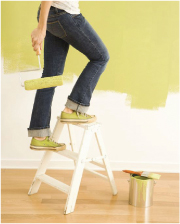
Painting a room is one of the simplest ways to achieve dramatic changes in your living space. Not only is a painting project easy even for a novice, but it’s also one of the most inexpensive ways to update a room. You’ll also feel a sense of accomplishment when the job is complete. Once the hard part of picking the paint shade is over, the job will go a lot smoother if you are well prepared.
Preparation
This is the most important step. Nearly all paint jobs that go awry are the result of a surface that wasn’t properly prepared. Below is a list of supplies to have on hand when you begin your painting project:
· drop cloth
· blue masking tape
· paint scraper · sanding sponge
· spackle
· putty knife
· TSP wall cleaner
· rags/sponges
· gloves
Patch cracks and holes: No matter the size of the crack or hole, fill it with a surfacing compound. Allow to dry before sanding.
Sand rough spots: To ensure paint adhesion, sand all rough spots to a smooth finish. This includes any paint runs from prior paint jobs. Sandpaper grit of 80 or 100 will work best on walls and trim.
Wash the walls with tri-sodium phosphate (TSP): This is a crucial step that should not be skipped. TSP is a heavy-duty surface cleaner that will remove grease, soot and mildew on walls, woodwork and painted surfaces. Rinse with clean water after applying.
Remove switch/outlet cover plates: It’s easy to want to skip this step, but your paint job will have a more professional look if you take the time to remove all light switch and electrical outlet cover plates before painting.
Tape woodwork: Using blue painter’s tape that is easily removed, tape all woodwork trim, baseboards, and window and door woodwork.
Primer: Apply primer to patched-over areas if needed. Many of the high-end paints on the market now do not require a primer.
Paint: Ensure excellent coverage by choosing the proper brush or roller. A good tip for even coverage is to roll a W in a three-by-three square, then fill the square with consistent vertical rolls. Be prepared with these supplies when you begin the actual painting process:
· brush
· roller
· paint tray
· disposable liners
· painter’s pole
· ladder
· brush cleaner
· bucket
Paint adhesion tips
To achieve the highest quality results, keep in mind these general guidelines to ensure a fabulous finish:
· Surfaces should be clean, dull, dry, sound, and smooth before applying a second coat.
· Previous peeling areas that are not stripped down to a bare surface will most likely continue to peel over time and require periodic touch-ups.
· Chalky surfaces should be cleaned thoroughly or paint will fade.
· Take proper lead-based paint precautions if your home was built before 1978.
· Latex paints dry quickly to touch but take at least a week to cure (harden). The more colorant added, the longer the cure time.
· Product additives may have a negative impact on the paint’s performance. Follow the label directions for best results.
· Paints and stains will take much longer to dry and cure if the time between coats is shorter or longer than recommended.
· If one heavy coat of paint is applied instead of several thin coats, the dry and cure will be greatly affected, particularly with neutral bases.
Good luck on your paint project and enjoy the results!
Tina Rotolo is the store manager and human resource director at Cole Hardware on Polk Street. She loves helping customers with do-it-yourself projects. Contact Tina or her staff at 415-674-8913 for any questions with your projects.